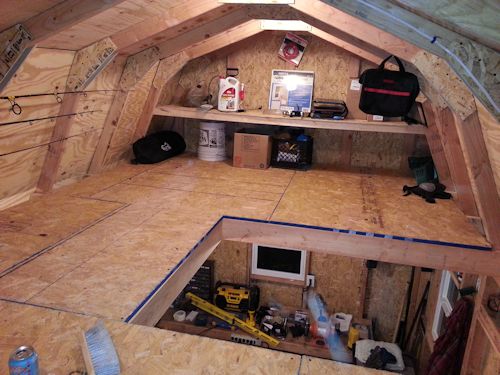
Alright, folks, let's talk sheds! You're ready to tame that clutter, get your garage back, and maybe even store your weekend toys in style. A 10x12 shed is a great starting point, and I'm here to walk you through the whole shebang â€" from planning to finishing touches.
First Things First: The Plan
Before you start digging holes and hammering nails, you need a plan. A shed isn't just a big box. It's your space, so make it work for you.
What's going in? Think about what you'll be storing. Tools? Lawn equipment? Seasonal decorations? Maybe a workshop? Knowing what you'll be putting in will help you determine the layout, windows, and even the floor.
Where's it going? Location is key! Consider sunlight, drainage, and access. You don't want to build your masterpiece only to find out it's in a swampy corner with no room for your truck.
Budget and materials: Sheds can range from budget-friendly to top-of-the-line. Figure out how much you're willing to spend and what materials you're comfortable working with. Pressure-treated wood is a good choice for the foundation, but you can get fancy with siding and roofing.
Local codes and permits: Don't forget about your local building codes and permit requirements! They vary from place to place, so check before you break ground.
The Foundation: Your Shed's Backbone
A sturdy foundation is the key to a long-lasting shed. You've got a few options:
Concrete: This is the most durable option, and it's relatively easy to build. You can create a full slab or just piers for your foundation. Be prepared to rent some tools and possibly hire help if you're unfamiliar with concrete work.
Pressure-treated wood: This is a budget-friendly and DIY-friendly option, but make sure you're using pressure-treated wood, or rot will be your worst enemy.
Gravel and timbers: For a more rustic look, you can use a bed of gravel with pressure-treated timbers for your foundation. Just make sure you have adequate drainage to prevent water pooling.
Framing Up: The Bones of Your Shed
Now it's time to get those walls up!
Floor joists: Start by building the floor frame, using pressure-treated lumber to create a strong base. You can choose a simple floor design or opt for a more complex layout with joists running both ways for extra support.
Wall studs: Use standard 2x4 lumber for your wall studs, spacing them 16 inches apart on center. This ensures stability and allows for easy attaching of sheathing.
Roof framing: There are numerous roof designs, but consider the size and slope you want. A simple gable roof is often the easiest to build. Use your framing lumber to build the rafters, ensuring proper support at the ridge board and the walls.
Sheathing: The Protective Layer
Once your frame is up, it's time to add sheathing for structural integrity and to prepare for the siding and roofing.
Walls: Use plywood or OSB (Oriented Strand Board) for wall sheathing. The sheets should be nailed to the studs securely, and you can even add insulation for warmth and soundproofing.
Roof: You can use plywood, OSB, or even metal roofing panels for the roof sheathing. Remember to include a vapor barrier if you're using plywood or OSB.
Siding: The Look of Your Shed
Now it's time to add the finishing touches and give your shed that personality.
Vinyl siding: This is a popular option for its durability, low maintenance, and variety of colors.
Wood siding: For a classic look, choose wood siding, but be aware that it requires more upkeep and repainting.
Metal siding: Metal siding is durable and low-maintenance, making it a good choice for a shed that will be exposed to the elements.
Roofing: The Weather Shield
Your roof protects your shed from the elements, so choose wisely.
Asphalt shingles: This is a budget-friendly option that comes in many styles and colors.
Metal roofing: Metal roofing is durable and long-lasting, and it can handle heavy snow loads.
Slate or tile: For a more upscale look, consider slate or tile, but be prepared for a higher price tag.
Doors and Windows: The Entry Points
Don't forget the doors and windows! They provide access and natural light.
Garage door: For larger sheds, consider a garage door for easy access to your gear.
Single doors: A simple single door is perfect for a smaller shed. You can opt for a double door for wider access.
Windows: Windows provide natural light and ventilation. Choose sizes and styles that suit your needs and aesthetics.
The Finishing Touches
You're almost there! Just a few more steps to create a finished shed.
Gutters and downspouts: These will help direct rainwater away from your shed, preventing water damage.
Painting or staining: Give your shed a fresh coat of paint or stain to protect the wood and add some personality.
Interior finishing: Consider adding drywall or paneling to the interior, and install shelves and hooks to keep things organized.
Electrical wiring: If you plan to use your shed for a workshop or need lighting, get your electrical wiring done properly.
Safety First
Building a shed is a rewarding project, but safety comes first.
Wear appropriate protective gear: Use safety glasses, gloves, and hearing protection.
Use sturdy ladders: Never stand on unstable surfaces or use makeshift ladders.
Follow instructions carefully: Pay close attention to the instructions provided for building materials and tools.
Be aware of your surroundings: Keep an eye out for potential hazards like exposed nails or uneven terrain.
Building a shed is a labor of love, and with careful planning and execution, you'll have a functional and beautiful space for years to come. Remember, it's YOUR shed, so make it reflect your personality and needs!
No comments:
Post a Comment